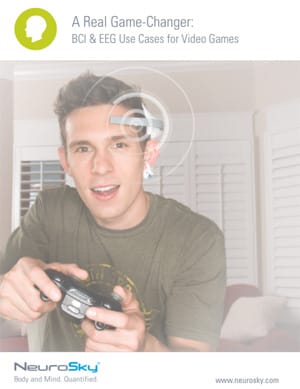The temptation to design headsets without ground-reference ear clips (electrodes) is pervasive. This is predominantly because ear clips remain vestiges of clinical EEG systems that have made their way into consumer BCI products. Clamped lightly onto a person’s earlobe, ear clips have proven one of the most trusted ways to obtain reliable grounding and referencing of the EEG system, but criticisms regarding their obstruction to aesthetic form factor designs have caused some peripheral companies to hesitate in pursuing consumer BCI headset projects. There are alternatives to ear clips that should be considered during the design process, but sometimes at the expense of a reliable contact point for the EEG circuit. (Note: in actuality, the ground electrode can be placed anywhere on the scalp or ear; it is the reference electrode that is the subject of this blog.)
Let’s look at some of the choices beyond the standard ear clip.
10/20 Electrode System – Referential (Monopolar) recording
Location: Auricle – the outer portion of the ear and a good placement location since the auricle has no nearby brainwave activity
Best Ways to Attach:
Cosmetic Ear Clips – ear clips have become more visually appealing, smaller and more comfortable to wear—think “consumer-friendly” ear clips. It’s still the most mechanically and electrically reliable solution that yields improved cosmetic advantages over the traditional medical ear clip
Loops / Hooks – another good contact point to the auricle is at the back of the ear. Oftentimes, the contact is in the form of a loop or a hook on the headset that secures the electrode material in this fashion. There are certain design challenges with this approach in terms of maintaining a secure fit. Many of these headset designs offer limited mobility, if not designed properly.
Headphones – headphones are a natural form factor for embedding ground and reference sensors that are in direct contact with the auricle. Different sensor materials can be optionally used.
Location: Mastoid – the rounded protrusion of bone just behind the ear; the bone is thick and dense enough to block out brainwaves from reaching the reference electrode.
Best Ways to Attach:
Electrode Arm – typically, a fixed arm (see black element in adjacent photo) on the headset containing the electrode(s) is lined up with the mastoid once the headset is placed on the user’s head. Again, there will be some mobility challenges as well as some discomfort due to pressure on the bone, if not designed properly.
10/20 Electrode System – Biopolar recording
Location: Scalp – unlike the previousy mentioned monopolar EEG systems, a bipolar EEG system places an electrode where there is brainwave activity. The chief advantage from a headset design perspective is the ability to remove the ear clip and place the reference electrode anywhere on the scalp. This is common for some headband and stretchable (tattoo) EEG sensor designs, though research1 has shown possible losses of good EEG data when using this system.
Non-10/20 Systems (Non-Traditional EEG Systems)
Location: In Ear – there are numerous attempts to push the boundaries of wearable EEG that run up against a non-conformance to 10/20 system rules. So, most parties in the EEG medical and clinical world are highly skeptical that these devices are capturing pertinent EEG data. Yet, some studies2 show promise that there could be useful EEG being collected by these non-traditional devices. The idea would be to integrate the EEG system (and thus the reference electrode) entirely into Bluetooth earbuds.
Photo #1 source – http://www.roblongo.com/services.php
Photo #2 source – http://mindbigdata.com/
Photo #3 source – http://www.amazon.com/NC-Digitech-Neurosky-Brainwave-Features/dp/B00S7TCYSW
Photo #4 source – http://3dfilaprint.com/emotivinsight-update-2/
Photo #5 – https://grandst.com/preorder/melon
Photo #6 – http://www.technologyreview.com/news/518356/device-could-spot-seizures-by-reading-brainwaves-through-the-ear/
Note 1: http://www.brainm.com/tfc/Publications/Fehmi%20Collura%202007.pdf
Note 2: http://www.commsp.ee.ic.ac.uk/~dlooney/PDFs/The%20In-the-Ear%20Recording%20Concept.pdf



